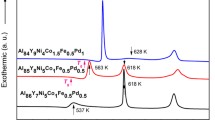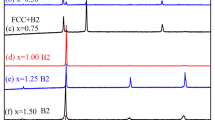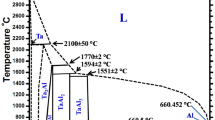Abstract
A multicomponent Al84Y9Ni4Co1.5Fe0.5Pd1 alloy was found to keep a mixed glassy + Al phases in the relatively large ribbon thickness range up to about 200 μm for the melt-spun ribbon and in the diameter range up to about 1100 μm for the wedge-shaped cone rod prepared by injection copper mold casting. The glassy phase in the Al-based alloy has a unique crystallization process of glass transition, followed by supercooled liquid region, fcc-Al + glass, and then Al + Al3Y + Al9 (Co, Fe)2 + unknown phase. It is also noticed that the primary precipitation phase from supercooled liquid is composed of an Al phase instead of coexistent Al + compound phases, being different from the crystallization mode from supercooled liquid for ordinary Al-based glassy alloys. In addition, it is noticed that the mixed Al and glassy phases are extended in a wide heating temperature range of 588–703 K, which is favorable for the development of high-strength nanostructure Al-based bulk alloys obtained by warm extrusion of mixed Al + amorphous phases. The Vickers hardness is about 415 for the glassy phase and increases significantly to about 580 for the mixed Al and glassy phases. The knowledge of forming Al + glassy phases with high hardness in the wide solidification and annealing conditions through high stability up to complete crystallization for the multicomponent alloy is promising for future development of a high-strength Al-based bulk alloy.








Similar content being viewed by others
References
Davis JR (1993) Aluminum and aluminum alloys, ASM international
Malek P, Janecek M, Smola B, Bartuska P, Plestil J (2000) Structure and properties of rapidly solidified Al–Zr–Ti alloys. J Mater Sci 35:2625–2633
Inoue A, Kimura H (2000) High-strength aluminum alloys containing nanoquasicrystalline particles. Mat Sci Eng 286:1–10
Zhu M, Yang GC, YaoLJ Cheng SL, Zhou YH (2010) Microstructure and mechanical properties of Al-base composites by addition of Al–Ni–Co decagonal quasicrystalline particles through a mechanical stirring route. J Mater Sci 45:3727–3734
Taketani K, Uoya A, Ohtera K, Uehara T, Higashi K, Inoue A (1994) Readily superplastic forging at high strain rates in an aluminium-based alloy produced from nanocrystalline powders. J Mater Sci 29:6513–6517
Tokuoka T, Kaji T, Nishioka T, Ikegaya A (2006) Development of high-strength, heat-resistant aluminum alloy made by powder forging process. SEI Technical Review 61:70–76
Inoue A, Yamamoto M, Kimura HM, Masumoto T (1987) Ductile aluminium-base amorphous alloys with two separate phases. J Mater Sci Lett 6:194–196
He Y, Poon SJ, Shiflet GJ (1988) Synthesis and properties of metallic glasses that contain aluminum. Science 241:1640–1642
Inoue A (1998) Amorphous, nanoquasicrystalline and nanocrystalline alloys in Al-based systems. Prog Mater Sci 43:365–520
Scudino S, Surreddi KB, Sager S, Sakaliyskaet M, Kim JS, Loser W, Eckert J (2008) Production and mechanical properties of metallic glass-reinforced Al-based metal matrix composites. J Mater Sci 43:4518–4526
Nieh TG, Wadsworth J (1991) High-strain-rate superplasticity in aluminum matrix composites. Mat Sci Eng 147:129–142
Inoue A, Kimura H, Amiya K (2002) Developments of aluminum- and magnesium-based nanophase high-strength alloys by use of melt quenching-induced metastable phase. Mater Trans 43:2006–2016
Gordillo MA, Cernatescu I, Aindow TT, Watson TJ, Aindow M (2014) Phase stability in a powder-processed Al–Mn–Ce alloy. J Mater Sci 49:3742–3754
Calin M, Grahl H, Adam M, Eckert J, Schultzl L (2004) Synthesis and thermal stability of ball-milled and melt-quenched amorphous and nanostructured Al–Ni–Nd–Co alloys. J Mater Sci 39:5295–5298
Inoue A, Sobu S, Louzguine DV, Kimura H, Sasamori K (2004) Ultrahigh strength Al-based amorphous alloys containing Sc. J Mater Res 19:1539–1543
Inoue A, Horio Y, Kim Y, Masumoto T (1992) Elevated-temperature strength of an Al88Ni9Ce2Fe1 amorphous alloy containing nanoscale fcc-Al particles. Mater Trans, JIM 33:669–674
Zhuo L, Pang S, Wang H, Zhang T (2009) Ductile bulk aluminum-based alloy with good glass-forming ability and high strength. Chin Phys Lett 26:066402
Wu NC, Zuo L, Wang JQ, Ma E (2016) Designing aluminum-rich bulk metallic glasses via electronic-structure-guided microalloying. Acta Mater 108:143–151
Inoue A, Matsumoto N, Masumoto T (1990) Al–Ni–Y–Co amorphous alloys with high mechanical strengths, wide supercooled liquid region and large glass-forming capacity. Mater Trans, JIM 31:493–500
Takeuchi A, Inoue A (2005) Classification of bulk metallic glasses by atomic size difference, heat of mixing and period of constituent elements and its application to characterization of the main alloying element. Mater Trans 46:2817–2829
Louzguine DV, Inoue A (2002) Influence of a supercooled liquid on crystallization behaviour of Al–Y–Ni–Co metallic glass. Mater Lett 54:75–80
Bassim N, Kiminami CS, Kaufman MJ, Oliveira MF, Perdigao MNRV, Botta Filho WJ (2001) Crystallization behavior of amorphous Al84Y9Ni5Co2 alloy. Mater Sci Eng 304:332–337
Nitsche H, Sommer F, Mittemeijer EJ (2005) The Al nano-crystallization process in amorphous Al85Y8Ni5Co2. J Non-Cryst Solids 351:3760–3771
Louzguine D, Inoue A (2002) Crystallization behaviour of Al-based metallic glasses below and above the glass-transition temperature. J Non-Cryst Solids 311:281–293
Inoue A, Ohtera K, Tsai A-P, Masumoto T (1988) Aluminum-based amorphous alloys with tensile strength above 980 MPa (100 kg/mm2). Jpn J Appl Phys 27:L479
Louzguine DV, Inoue A (2001) Full or particle replacement of Y by rare-earth and some other elements in the Al85Y8Ni5Co2 alloy. J Light Met 1:105–109
Kim HY, Inoue A, Masumoto T (1991) Ultrahigh mechanical strengths of Al88Y2Ni10−xMx (M = Mn, Fe or Co) amorphous alloys containing nanoscale fcc-Al particles. Mater Trans, JIM 32:599–608
Inoue A, Nakazato K, Kawamura Y, Tsai A, Masumoto T (1994) Effect of Cu or Ag on the formation of coexistent nanoscale Al particles in Al–Ni–M–Ce (M = Cu or Ag) amorphous alloys. Mater Trans, JIM 35:95–102
Inoue A (2000) Stabilization of metallic supercooled liquid and bulk amorphous alloys. Acta Mater 48:279–306
**e YQ, Peng K, Liu XB (2004) Influences of xTi/xAl on atomic states, lattice constants and potential-energy planes of ordered FCC TiAl-type alloys. Phys B 344:5–20
Inoue A, Ohtera K, Masumoto T (1988) New amorphous Al–Y, Al–La and Al–Ce alloys prepared by melt spinning. Jpn J Appl Phys 27:736–739
Louzguine DV, Inoue A (2002) Investigation of structure and properties of the Al–Y–Ni–Co–Cu metallic glasses. J Mater Res 17:1014–1018
Yang H, Dong P, Wang J, Li Y (2007) Glass formability and structural stability of Al-based alloy systems. Mat Sci Eng A-Struct 449:273–276
Wang JQ, Liu YH, Imhoff S, Chen N, Louzguine-Luzgin DV, Takeuchi A, Chen MW, Kato H, Perepezko JH, Inoue A (2012) Enhance the thermal stability and glass forming ability of Al-based metallic glass by Ca minor-alloying. Intermetallics 29:35–40
Hirata A, Hirotsu Y, Amiya K, Nishiyama N, Inoue A (2009) Fe23B6-type quasicrystal-like structures without icosahedral atomic arrangement in an Fe-based metallic glass. Phys Rev B 80:140201
Saida J, Yamada R, Wakeda M (2013) Recovery of less relaxed state in Zr–Al–Ni–Cu bulk metallic glass annealed above glass transition temperature. Appl Phys Lett 103:221910
Hirata A, Hirotsu Y, Amiya K, Inoue A (2010) Quasicrystal-like structure and its crystalline approximant in an Fe48Cr15Mo14C15B6Tm2 bulk metallic glass. J Alloy Compd 504:186–189
Louzguine DV, Bazlov AI, Ketov SV, Greer AL, Inoue A (2015) Crystal growth limitation as a critical factor for formation of Fe-based metallic glasses. Acta Mater 82:396–402
Bassim N, Kiminami CS, Kaufman MJ (2000) Phases formed during crystallization of amorphous Al84Y9Ni5Co2 alloy. J Non-Cryst Solids 273:271–276
Inoue A, Kong FL, Zhu SL, Liu CT (2015) Development and applications of highly functional Al-based materials by use of metastable phases. Mater Res 18:1414–1425
Acknowledgments
The present research is supported by Recruitment Program of Global Experts “1000 Talents Plan” of China (WQ20121200052), JSPS KAKENHI Grant Number 26630299 in Japan, Deanship of Scientific Research (DSR), King Abdulaziz University, Jeddah, Saudi Arabia (1-1-1435/HiCi), and the Ministry of Education and Science of the Russian Federation in the framework of the Program aimed to increase the competitiveness of the National University of Science and Technology “MISiS” (No.K1-2015-026).
Author information
Authors and Affiliations
Corresponding author
Ethics declarations
Conflict of interest
The authors declare no conflict of interest.
Rights and permissions
About this article
Cite this article
Han, F.F., Inoue, A., Han, Y. et al. High formability of glass plus fcc-Al phases in rapidly solidified Al-based multicomponent alloy. J Mater Sci 52, 1246–1254 (2017). https://doi.org/10.1007/s10853-016-0394-6
Received:
Accepted:
Published:
Issue Date:
DOI: https://doi.org/10.1007/s10853-016-0394-6




